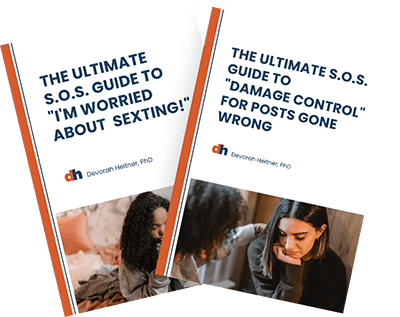When we think about getting our kid their first phone or giving them a tablet or laptop, parents often think about what apps we’ll allow, which social media platforms are age-appropriate, and staying aware of what they’re doing online. All great things to be mindful of as you raise kids in the digital age! A commonly overlooked topic, however, is the contacts or connections your child can access from their phone or tablet.
Before your young communicator jumps in and wants to connect with everyone they possibly can, first, it is important to consider their “universe” of connections. The younger they are, the more hands-on you’ll want to be about mentoring your kid about these choices.
When you first hand a new device to your child, brainstorm together about some age-appropriate boundaries for contacts.
Different Contacts at Different Stages
Here are some age-appropriate examples from families I’ve worked with:
- Elementary school – parents know all contacts/ friends/followers.
- Middle school – Parents probably know many kids your child connects with, but you may not have personally met. This could be a classmate your child talks a lot about, but you haven’t greeted face-to-face. Kids should be comfortable turning down a connection request or disconnecting with someone who’s bothering them, or if the relationship has ended. If they follow celebrities or certain topics, that’s where they can connect with people they don’t know personally, and they should be prudent about those connections.
- High School – Their universe of contacts is largely their own, but they need to know how to access help if harassment or other tricky issues arise. Depending on your assessment of their judgment, you may want to ask them about unfamiliar contacts.
- Getting ready for or entering college – you might not be familiar with many of their connections as they’ll be expanding their networks in their interest areas and professional life. Context overlap can become an issue (i.e. when you’re connected to people with whom you might have both personal and professional relationships.)
If you give your child the green light to create a social media profile be sure to discuss criteria for who to send and accept contact requests from. For instance, your son may want to only chat with people he knows in real life (IRL), like family and friends. Adults outside of the family are a special case. Maybe the parents of close friends are a yes, but the parents of the kids you babysit for are a no. Your older child probably won’t want to connect with teachers on a social platform, unless it is part of an assignment (ie the class is on Twitter) but a younger child might, so it’s worth reminding kids about what channels are appropriate for connecting with teachers (usually email) and which ones aren’t.
Your Child’s Universe of Contacts
Once your child has started building their world of contacts, keep the conversation going with regard to the content of their friend’s post. Ask your child how specific posts make them feel, what posts they find entertaining or funny, and which ones make them feel uncomfortable or upset. This will also give you some deeper clues into your child’s personality and can offer some opportunities where you can step in and act as a good role model.
Brainstorm with your child how to respond if some of their contacts are unkind on social media or on group texts or private text threads. Keep the dialogue open and ongoing to encourage your child to consider their own behavior and that of others.
As they’re adding contacts, this is also a great time to discuss when they might want to disconnect from some people. Think about your experience, be open and share some examples. Perhaps you unfollowed or disconnected from a friend or colleague because their posts were overly negative or maybe they posted incessantly.
Slow and Steady: Adding Contacts Mindfully
If you can empower your child to build their contact list slowly and deliberately, this can help them to avoid overwhelm later on when they scroll through their contacts and don’t recognize half of them. Make sure your child knows it’s perfectly fine to simply ignore requests from people she doesn’t know or doesn’t want to chat with. If they’re elementary age, give your child permission to blame you for limiting contacts. He can say, “My phone is new and my parents have to review new contacts first.” Or “Once we’ve had a playdate and my dad meets you, we can add you to the Minecraft server.”
Strategies for Thinking About Contacts
- Start with just a small number of contacts: add immediate family as contacts first, then expand to extended family.
- When adding friends, add just a close friend or two at a time, and avoid adding the entire class at once.
- Make sure your child knows that they’re never obligated to share their phone number.
- Have them think through ways to say “no” that they’re comfortable with. Blaming you might be the best option for younger kids!
- Work with your child to brainstorm contacts that he may need such as the phone numbers for kids/parents in carpool, emergency contacts, etc.
- Periodically check in to discuss new contacts with a novice communicator.
Too Many Contacts: What to Do
First, don’t freak out (sound advice that applies to most parenting moments). Your child may have enthusiastically added numerous contacts because they didn’t want to say no, or having a lengthy list of friends makes them feel good. They may need to adjust the rate of adding new contacts.
Sometimes kids worry about being rude, so they accept everyone. Many kids feel like the number of connections represents having a lot of friends and being cool. Who doesn’t want to have a lot of friends? If all is well, they may not need to edit, but it’s important to consider the emotional energy and time involved in staying in touch with so many people.
Maintenance: Keeping Contacts Current
Review your child’s list of contacts and figure out who you recognize. Kids often add a lot of connections by default. Discuss having a contact cleanup day and remove people they don’t know or don’t really want to stay in contact with. If your child doesn’t remember who some contacts are, they can remove these too. Also, talk with your kids about how you clean out your contacts and keep them current. When you get a new device or even a new app is a great time to revisit everyone’s list of connections to keep it fresh.
Transitions like graduating from middle school are a great time to go through all of your contacts and make sure you want to keep them. That friend from camp three summers ago that you haven’t spoken to, or the person who posts really gross videos might be worth pruning. If your child really needs a fresh start after a major social transition, you can offer them a new phone number.
Ultimately, our digital devices should serve us, and make it possible to extend and enjoy our friendships and our interests. They shouldn’t make us (or our kids) constantly stressed or feel like we have another job. Much of the way our kids feel when they use phones and tablets has to do with who’s on there with them.
And that’s something that they have some control over!
If you enjoyed this article, you might like these too:
- Your Child’s First Cell Phone: How to Know When They Are Ready… and How to Know When YOU Are Ready
- Forget New Year’s Resolutions— Set intentional tech habits
- 6 Truths About Parenting Tweens in the Digital Age
Has your child been asking you for a phone or have they been using one for a year or so and it’s not going so great? If you’re sick of the fighting with your child and wondering how to help them succeed with a phone without it taking over their lives (or yours) and constantly wondering, what are they doing on there? Phonewise: Bootcamp for Parents can help your family wade into this new territory.

